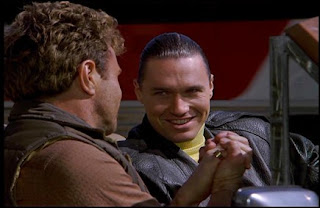
My trips to the multiplex have been few and far between in the last year or so. On my most recent visit to one, however, whilst giving an old and dear friend of mine the old "Kremer Tour" of New York City, we decided to end the day by seeing a movie...and since he is not particularly a cineaste, we wound up at a multiplex. I noticed something in the theater lobby that functioned as the culmination of a continuing observation. I noticed the poster for the film State of Play nearby. Awhile ago, when I purchased both Woody Allen's Cassandra's Dream and Cronenberg's Eastern Promises on DVD, I noticed instantly how strikingly similar the cover art-design seemed for both those films. Furthermore, upon first recently seeing the DVD cover for the new release Frost/Nixon, I came to realize how similar the DVD art for that film seemed to that of Cassandra's Dream and Eastern Promises. Then, this was almost immediately compounded upon witnessing the State of Play art hanging in the lobby of the multiplex. To put it...mmm, bluntly...the art is all rather "boxy," if you catch my drift. They rely on the arrangement of enclosed spaces, boxes (many of which are headshots), within a larger field of enclosed design space. The boxes are arranged in such a way that one might say the arrangement lends to the films the look of ham-fisted soberness that graphic designers often use to provoke the prospect of "commercially heavy" subject-matter and/or edge-of-your-seat drama in audiences. The meretricious "box-happy" design seems to be trend in movie art design within the last five years. Okay, that may or may not be all well and good, but as it turns out, these three are not the only examples...not by a long shot. No. Above, you will observe eight titles that ostensibly use an identical template.
It is fair to note that, before this article was fully written and when the "Coming Soon" sneak-peak of the article had been posted, fellow blogger, film studies scholar and friend Chris Cagle at the Category D blog used the coming-soon post as a launching pad for his own speculation about the recent "box-happy" trend in movie art. Cagle says, "Dan Kremer notices the lack of originality in movie posters. My initial thought is that the template quality reveals the absence of high concept material and is a way to communicate genre without it. And like genre, the difficulty is that while too much repetition is not optimal in selling films, neither is too much originality."
As a self-described Saul Bass enthusiast, I think I can make a confident claim that the days of high-concept movie art have gone the way of the dodo, and with it, a mainstream marketplace for high-concept cinema. Compare the real poster for the recent Frost/Nixon with the way the poster would have looked in the hands of moviedom's favorite graphic designer Saul Bass. Thus, we have been led hook, line and sinker into a time when the vacuous annual "Oscar bait" is simply self-conscious "prestige cinema" -- and the art for such cinema is in direct proportionality to this condition. The movie poster (as opposed to the DVD cover) for Frost/Nixon suggests a different approach, if nothing at all spectacular or even attractive to the eye. In the design of the cover, however, the distributor has opted for the evidently popular boxy template. What does it truly suggest? In 1970's cinema, boxes in mainstream movie art served a completely different function, suggesting star-powered vehicles, often in the disaster movie subgenre. Posters were always in competition with each other, it seems (i.e. "How many boxes, i.e. headshots of stars, can we include on the poster, meaning how star-studded is our film compared with others?")

Above, you will see posters for three all-star 1970's genre flicks: The Towering Inferno, Capricorn One and Voyage of the Damned (the latter two being big budget Sir Lew Grade/ITC productions). The boxes in these instances act as bait, as a means of luring in audiences. If you saw small headshots of actors below the actual movie art, this usually indicated a disaster picture. However, the boxes in these posters serve definitive purposes and possess a clear objective. The movie art of now does not seem to have such an objective, other than the evocation of the "prestige picture" flavor. Often, the headshots in the box-happy art of now is aimed at lending an austere and heavy-handed gravitas, as films began losing their explicit genre elements and it is in this sense that I agree with Cagle's analysis of this "phenomenon". Take a look around at your local video store. Design like this is everywhere! Has classic movie art become an outmoded novelty? An exercise in passé? Notice how posters up until the 1980's (I will venture to say 1982 was when a shift began occuring) were often drawn or sketched. If photographic art was used, it was sparingly. Posters of today use actual photographic representation of the film they are advertising.
What is it, really? A pervasive laziness in studio advertising departments? A capitalist malaise where the photographic (hence this obsession with boxes) is thought to be more effective and has hence replaced the actual "art" of movie art? A growing distaste for the "quaint but superfluously baroque" movie art of pre-1980? Too little time, too many movies? What truly accounts for a lack of originality in these designs? Questions, questions, questions...who knows? But now I'm going to go look at the hand-drawn Elliott Gould caricature in the cartoon poster for Altman's The Long Goodbye (1973) now and wax nostalgic for a time in which I didn't exist. Take me back, doo doo doo doo!
POST-SCRIPTUM: Another box-happy example: the DVD cover of The Last Word (2008), just saw it a few seconds ago (I am at the Denver Airport awaiting a connection).




